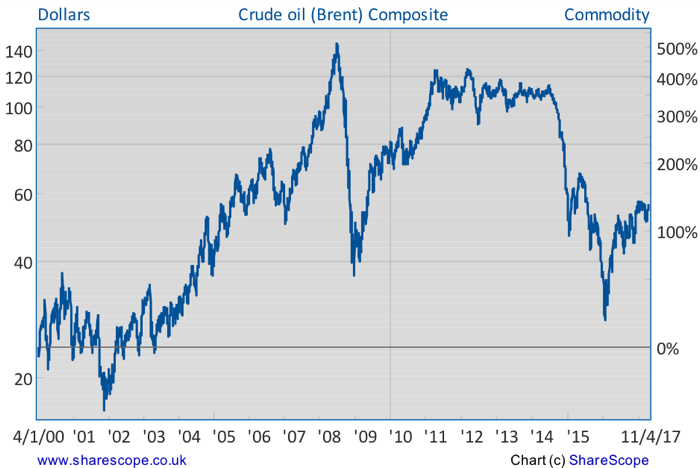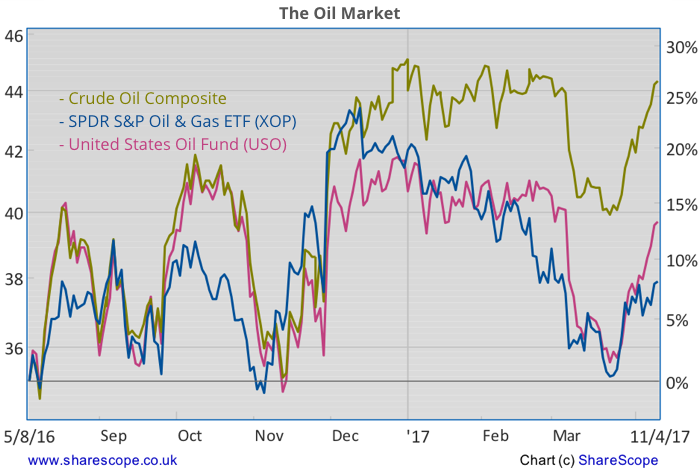Is there any upside in oil?

Far from memory is the time when Saudi Arabia and OPEC were in control of global oil prices, as are oil prices above $100. A nascent fracking industry in the US, deteriorating social conditions in some oil producing countries and a desire in Saudi Arabia to retain market acted like an explosive mix that changed the fundamentals of the market. If OPEC still has the ability to put a floor on prices, the US fracking industry has the ability to put a ceiling on them.
Every time prices go down significantly, OPEC cuts production. But, at the other extreme, every time oil prices start rising, the fracking industry starts adding output and thus limits upside price potential. With the fracking industry having been able to decrease breakeven prices, the upside limit on oil prices will be ever lower. For this reason, I’m not bullish long term on oil. The fundamentals behind the supply side are concerning and demand has also been struggling to grow. Part of that demand may be permanently lost to alternative energies. But in the short term, things may be a little different.
The last 8-10 years have been interesting in terms of price action in oil markets. In July 2009, oil hit a record high of $146. Back then everyone was bullish on the commodity, with supply seen as being unable to meet demand. But the financial turmoil quickly proved that what goes up must go down, and just a few months later oil was trading as low as at $36. With OPEC unable to react to the heavy reduction in global demand incurred through financial collapse, prices adjusted rather quickly. But later, after some output adjustments, oil prices started to recover, hitting the $100 level again by January 2011, and then moving sideways until October 2014. But if losses taken during the financial crisis were easily reverted, that was not the case during the 2014 crash that smashed oil prices down to $28 per barrel. In January 2016, oil was still trading in one of its worst bear markets on record.
Later in 2016, oil started to recover, but much less vigorously than during previous bull markets. Initially, Saudi Arabia was trying to bust the whole US fracking industry, through avoiding any cuts to output. But all that resulted was a collapse of traditional oil producing countries, with Saudi Arabia itself also running into some financial problems. While the fracking industry sits idle when oil prices are at $30, they quickly restart operations as soon as oil prices recover.
To some extent, any output cuts initiated by OPEC help the fracking industry to regain life and engender lower prices in the longer term. That is the main reason why Saudi Arabia was trying to bust everyone before cutting production. But later in 2016, Saudi Arabia changed its strategy and brokered an historical agreement to cut oil output. The agreement was finally reached on 30 November, and involved the thirteen OPEC members, which agreed to cut production by 1.2 million barrels a day for a six month period. A group of ten non-OPEC countries, led by Russia, joined the lot cutting another 558,000 barrels a day.
Before OPEC’s decision, oil prices were around the low $40s. By the end of the year they hit $57. Only time will reveal the implications in terms of shale oil production in the US, but for now OPEC is sticking to its commitment. Saudi Arabia, a country that enjoys the lowest costs of production of any oil producing country, is strongly committed to the production cut, having trimmed its production by 700,000 barrels a day at one point.
Back on 13 February I explained my bearish long-term case for oil. I expressed the same sentiment I share today with regard to OPEC’s losing control of the oil market. Optimism in February was huge, as oil prices were benefiting from OPEC’s decision. Oil was trading at $45 and Keane Group (NYSE:FRAC) was able to raise $508.4 million in its stock market debut (on 20 January). But since that time, when the ratio of call to put options was 9 to 1, sentiment has deteriorated. Keane Group is trading at $16.25, down from $21.62, and oil prices are now below the $57 level they were trading at the beginning of the year, as oil stockpiles are accumulating faster than expected.
While I’m neutral to bearish on this market over the long term, I believe there may be some upside opportunities in the shorter term as OPEC may try to extend a policy that has succeeded so far. Five months after the agreement reached on 30 November, the glut is still far from being solved but oil prices are substantially higher and more stable. There is no reason for OPEC members to abandon the current output cuts. A few days ago, the WSJ reported that Saudi Arabia may be pushing for an extension of the production cuts. If those cuts materialise on 25 May, we may see another run-up in oil prices similar to the one we saw in the November-December period. If that proves to be the case (I believe the odds are good), oil prices may reach the $67 level last seen in May 2015. On 21 April a midlevel OPEC committee meeting will take place, from which recommendations will be suggested to OPEC’s energy ministers. By then we will get a clearer picture about what can happen in May.
So while keeping a weak long-term view on oil, I believe there is a strong case to take a long position today and keep it until the end of May. There are several ways of doing this. One would be to purchase oil futures directly. A cheap and easy alternative is to use spread betting to get exposure. Another is to find an ETF with a good correlation with oil. Usually, it is impossible to get direct exposure to spot prices, such that, in choosing an ETF, an investor would have to choose between getting indirect exposure to the futures price or getting indirect exposure through the energy industry. The United States Oil Fund (NYSEARCA:USO) gives exposure to futures. The SPDR S&P Oil & Gas Exploration & Production ETF (NYSEARCA:XOP) gives exposure to explorers and producers, which would indirectly benefit from price rises. While this second option has less correlation with oil, it is not exposed to the contango/backwardation issues that impact futures prices.


Comments (0)